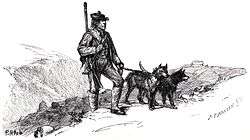Per Gynt

"Per Gynt" (Norwegian pronunciation: [ˈpær ˈjynt]) is a Norwegian fairy tale which originated in the traditional region of Gudbrandsdal. It encompasses the themes of identity and relationship.[1]
"Per Gynt" tells the folktale of the eponymous Per Gynt and his various exploits. Per Gynt was a hunter from Kvam in Oppland. He rescues three dairy-maids from trolls and shoots the Bøyg, a troll which takes the form of a gigantic serpent and stands as a hindrance to travellers. The fairy tale is most famously recorded by Peter Christen Asbjørnsen and Jørgen Moe in Norwegian Folktales (Norske Huldre-Eventyr og Folkesagn) which was first published in 1845.[2] [3][4]
The folktale also served as inspiration for Henrik Ibsen's play Peer Gynt which was published in 1867. The play appeared on stage in 1876, accompanied by incidental music by composer Edvard Grieg who composed the Peer Gynt Suite.[5][6][7] [8]
References
- ↑ "Per Gynt". Store norske leksikon. Retrieved November 1, 2017.
- ↑ "bøyg". Bokmålsordboka. Retrieved November 1, 2017.
- ↑ "Asbjørnsen's "Høifjeldsbilleder"". per2peer. Retrieved November 1, 2017.
- ↑ "Peter Christen Asbjørnsen (1812–1885)". per2peer. Retrieved November 1, 2017.
- ↑ "Grieg's Peer Gynt Suite". favorite-classical-composers. Retrieved November 1, 2017.
- ↑ Erik Bjerck Hagen. "Peer Gynt". Store norske leksikon. Retrieved November 1, 2017.
- ↑ "Peer Gynt, A synopsis of the play by Henrik Ibsen". TheatreHistory.com. Retrieved November 1, 2017.
- ↑ "Peer Gynt – history and synopsis". Det Norske Ibsen Kompaniet. Retrieved November 1, 2017.
Other sources
- Hult, Marte H. (2003). Framing a National Narrative: The Legend Collections of Peter Christen Asbjørnsen. (Wayne State University Press). ISBN 0814330061.
- Meyer, Michael (1974) Ibsen: A Biograph (Abridged edition. Pelican Biographies ser. Harmondsworth: Penguin) ISBN 014021772X
External links
| Wikisource has original text related to this article: |
